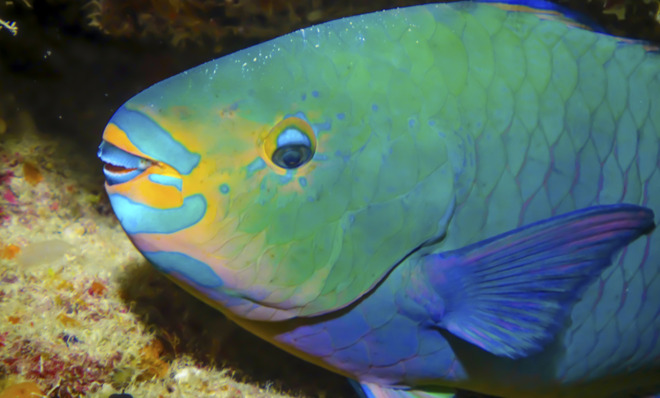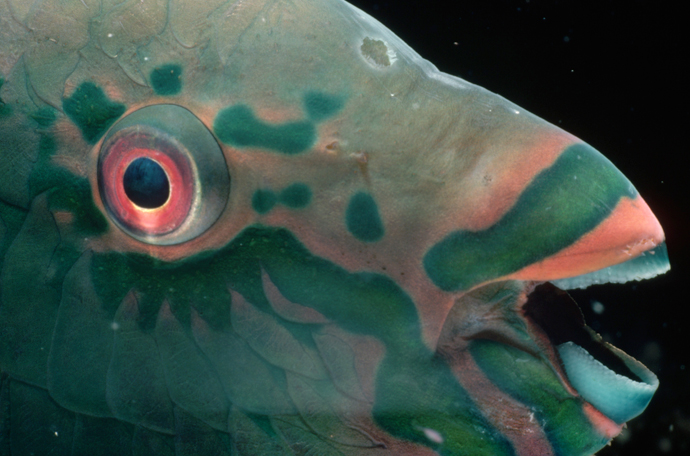Meet the sand-pooping, reef-saving, hermaphroditic parrotfish
Hawaii's reefs are under algae attack. One wacky fish with a mouth of steel might be able to turn the tide.

You'll probably hear the parrotfish before you see them. The animals chomp through solid rock and coral with fused beaks. When you're snorkeling on one of Hawaii's reefs, the noise is unmistakable. Crunch, crunch, crunch.
To watch the grazers at work, it would be easy to mistake parrotfish for the bad guys. Their chompers scar the reef with deep gouges and reduce what was once hard stone into nothing more than a cloud of sand, squirted unceremoniously out the fish's backsides.
Yes, that is what happens.
The Week
Escape your echo chamber. Get the facts behind the news, plus analysis from multiple perspectives.

Sign up for The Week's Free Newsletters
From our morning news briefing to a weekly Good News Newsletter, get the best of The Week delivered directly to your inbox.
From our morning news briefing to a weekly Good News Newsletter, get the best of The Week delivered directly to your inbox.
Parrotfish eat the algae that grows on rocks and coral. Special plates in the throat called the pharyngeal mill grind up all that material, and the fish literally poop out sand as a result — each parrotfish poops out up to 840 pounds a year. But according to Darla White, a marine scientist with Hawaii's Division of Aquatic Resources (DAR), parrotfish are actually integral to both the reefs' day-to-day health and long-term resiliency.
"It's all about real estate on the reef," says White. "Every living thing is just looking for space, and each bite the parrotfish takes opens up an opportunity for coral larvae to settle in."
Those bites are more valuable now than ever. Coral reefs thrive on clean, clear, low-nutrient water. But runoff from the islands contains fertilizers from farms and lawn care, and these excess nutrients cause both naturally occurring and invasive algae to go haywire. Before you know it, all the available real estate is shellacked with fast-growing algae, and the extremely slow-growing coral can't colonize these surfaces. Parrotfish keep these blooms in check by beak-biting straight down to the substrate.

Unfortunately for the reefs, parrotfish are freaking delicious. They are also beautiful. And that means the fish are a prized target of both subsistence-, sport-, and even some commercial-fisherman. Most herbivores don't take a hook, but spearfishing and nets work well enough. Add to this the unfortunate fact that many species of parrotfish are also really heavy sleepers, and you can see there's a problem. At night, they secrete a layer of mucous across their body that's thought to protect them from parasites and perhaps keep predators from sniffing them out. But it does nothing to prevent unscrupulous night divers from plucking the fishies from the reef like cooling pies off the proverbial windowsill.
A free daily email with the biggest news stories of the day – and the best features from TheWeek.com
To combat these pressures, White and her colleagues at the DAR designated part of the reef along West Maui's coast as the Kahekili Herbivore Fisheries Management Area in 2009. This made it illegal to kill or injure several species of herbivorous fish, including parrotfish, surgeonfish, and sea chubs, as well as sea urchins anywhere in the preserve. After several years of watching and waiting, they analyzed the results in 2012 and reported that parrotfish biomass had actually doubled. What's more, they found a strong positive relationship between total parrotfish biomass and the amount of coral growing on the reef.
Problem is, White says only 1 percent of Hawaii's coral reefs are under this kind of protection — which means most of the region's parrotfish are getting picked off before they can even reach full size. And this is a problem, because when it comes to parrotfish reproduction, size matters.
Hawaii's parrotfish live in harems — one guy to half a dozen or more gals — but every fish begins its life as a female. If the harem's male gets speared by a diver or otherwise decides to go out for a pack of smokes, the most dominant female can, over time, turn herself into a male.
You can tell when a female is going through this miraculous transformation because she will start to change from a dull gray to the more striking blues, greens, and purples of parrotfish males. And because the change doesn't just simply happen overnight, it's not uncommon to see a parrotfish swimming around that's half gray (female) and half green (male).
Before the color change is complete, some species of parrotfish use their half-and-half status as camouflage, deftly sneaking into harems that still have a super-male and fertilizing the females' eggs before the alpha fish knows what's up. (Note: This is known as "streaking" (through the Quad), and it's a good way to get your ass beat. Parrotfish are highly territorial.)
It should come as no surprise then that the biggest, beefiest, most flamboyantly colored parrotfish — which you now know to be exclusively male — are at the highest risk of human predation. This makes repopulating the reefs with algae-eaters all the more difficult, since males aren't simply hatched — they're built, over time and circumstance.
"It's human nature to try to fix something once it's broken," says White, regarding the state of Hawaii's reefs. "But to try to fix an entire ecosystem, especially one that's in the water? It's not easy."
But that won't stop them from trying. The DAR has partnered up with organizations like the Coral Reef Alliance and local businesses like The Snorkel Store to educate policymakers and actually get them in the water to see what's at stake. They've worked with hotels and landscapers to raise awareness about runoff. And the Coral Reef Alliance established something called the Fish-Friendly Business Alliance, which promotes businesses that don't sell fish food — because if grazers are eating pellets out of the hands of tourists, they don't have to eat as much algae.
Whether it's reducing algae and pollution or giving parrotfish populations a chance to rebound, the goal is to return Hawaii's reefs back to some semblance of balance — or lokahi, as the locals might say. Here on the mainland, I think that translates to, "You break it, you bought it."
Jason Bittel serves up science for picky eaters on his website, BittelMeThis.com. He writes frequently for Slate and OnEarth. And he's probably suffering from poison ivy as you read this.
-
 Pakistan: Trump’s ‘favourite field marshal’ takes charge
Pakistan: Trump’s ‘favourite field marshal’ takes chargeIn the Spotlight Asim Munir’s control over all three branches of Pakistan’s military gives him ‘sweeping powers’ – and almost unlimited freedom to use them
-
 Codeword: December 6, 2025
Codeword: December 6, 2025The daily codeword puzzle from The Week
-
 Sudoku hard: December 6, 2025
Sudoku hard: December 6, 2025The daily hard sudoku puzzle from The Week